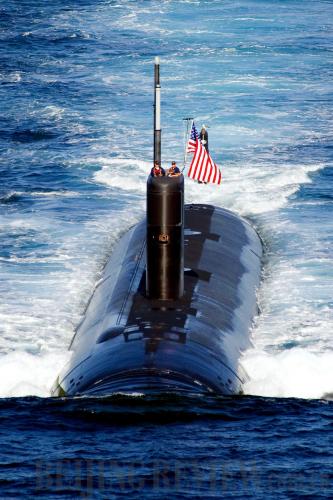|
 |
|
DETECT AND ATTACK: The Los Angeles-class attack submarine USS Tucson (SSN 770) takes part in the U.S.-South Korea joint naval and air exercise in the Sea of Japan on July 26 (XINHUA/AFP) |
The United States understood this. Sending an aircraft carrier to the exercise would clearly offend China, and the United States would pay a price.
But if the United States didn't send an aircraft carrier, hardliners, both at home and in South Korea, would accuse Washington of succumbing to Beijing. Therefore, U.S. decision makers kept alternating between national dignity and long-term diplomatic interests, and the exercise was delayed again and again.
Security patterns
The extensive concern of Northeast Asian countries about the exercise showed the severe security situation in the region. Generally speaking, the security pattern in Northeast Asia has a number of features.
For instance, the U.S. political and military presence remains a dominant factor in the security pattern of Northeast Asia. Meanwhile, China's influence is surging. No international force, including that of the United States, can neglect China's concerns and stances. Changing the location to the Sea of Japan proved the United States and South Korea's cooperative attitude toward China.
What's more, the military confrontation on the Korean Peninsula is a key issue in Northeast Asian security. In recent years, it has become the most prominent factor for instability in the region.
In the North Korea-South Korea confrontation, in terms of military strength alone, South Korea is in a weaker position. Therefore, it has been making efforts to enhance its military strength to deal with the threat of North Korea.
North Korea has long adopted a military-first policy. And it is also making progress toward nuclear weapons. Since it has made a breakthrough in nuclear fusion, it will maintain long-term military superiority and nuclear deterrence over South Korea.
In fact, the essential reason for the tension in Northeast Asia is that the confrontational structure formed during the Cold War has not fundamentally changed. This structure includes the North Korea-South Korea confrontation; the U.S.-Japan alliance and U.S.-South Korea alliance and their potential confrontation with China and Russia; and the unresolved Japan-Russia and Japan-South Korea territorial disputes.
Of course, despite these conflicts, we can also see progress, including the improvement of China-South Korea relations and the deepening of China-U.S. cooperation and interdependence.
Although there is still no timetable for a final solution to the conflict on the Korean Peninsula, it is largely under control. Even if North Korea obtains nuclear weapons for use, it won't easily resort to them, given its relatively weak position in Northeast Asia. Therefore, it is not able to change the basic security pattern of the region.
To protect its own strategic interests, the United States will seek to dominate the region's long-term security pattern. As a result, it may run into disagreements and conflicts with Northeast Asian countries. Somewhat troubled relations between the United States and North Korea, Japan, South Korea, Russia and China reflect these countries' opposition to U.S. dominance and hegemony in the region. These conflicts will not disappear, so long as Washington's strategy remains unchanged.
Of course, U.S. control has also produced some positive results. For instance, it has inhibited, to some extent, the Japanese right-wing forces' intention of rearming Japan.
With the rapid enhancement of China's national strength, China's influence in the region is surging. This is another dramatic feature of the Northeast Asian security pattern. China's influence does not come from its enhanced military strength, but from its economic power.
In the 1990s, Japan and South Korea's biggest trading partner was the United States. However, after entering the 21st century, great changes occurred in the economic situation of Northeast Asia. China became their biggest trading partner, and the two countries' reliance economically on China has surpassed their reliance on the United States.
Japan's trade with the United States as a percentage of its total foreign trade volume dropped from 27.4 percent in 1990 to 13.5 percent in 2009, while its trade with China as a percentage of its total foreign trade volume increased from 3.5 percent to 20.5 percent. Therefore, China's economic prosperity directly affects the economic security and development of Japan, South Korea and others, giving China a considerable influence in the region.
The author is a professor with the Institute of International Relations of the China Foreign Affairs University | 